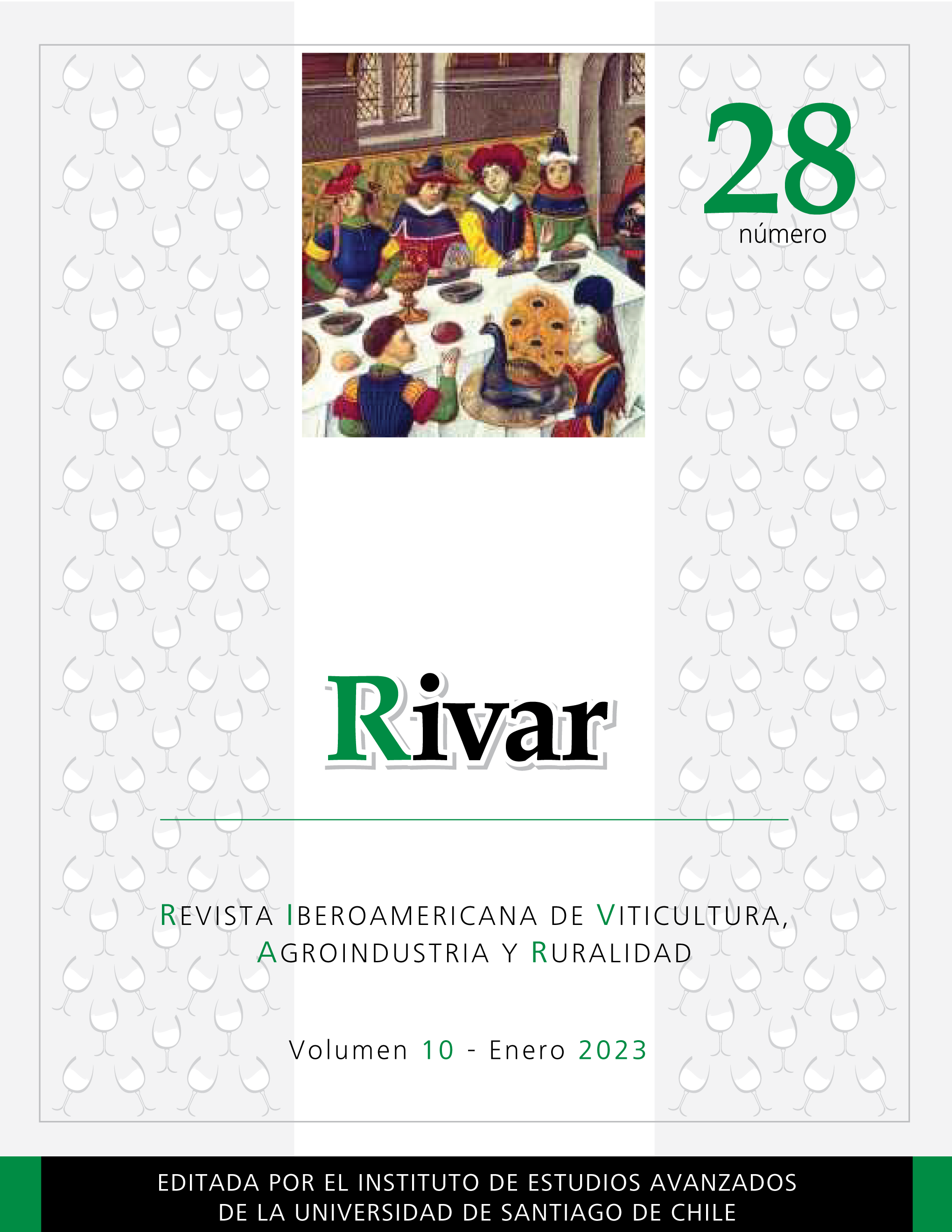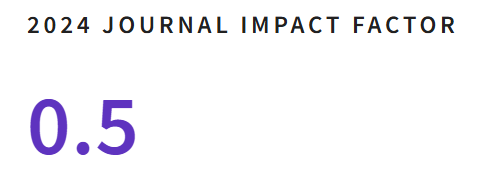Andean Viticulture: Edaphoclimatic Characterization of Vineyards Located in the Codpa Valley
DOI:
https://doi.org/10.35588/rivar.v10i28.5492Keywords:
altitude, bioclimatic indices, soil analysis parameters, Pintatani wineAbstract
Viticulture in Codpa is developed in altitude under a subtropical climate, where the vines present a series of physiological disorders due to the lack of chilling hour accumulation. The goal of this research was to characterize the soil and climate conditions of the Codpa Valley vineyards. The results showed that soil pH of the vineyards of Codpa Valley was alkaline, whereas the soil electrical conductivity varied from 0.81 to 2.10 mmhos/cm. Soil nitrogen content was low (≤ 20 ppm), whereas soil boron content was high (≥ 2.00 ppm). Climate of Codpa is characterized as intermediate according to the Growing Season Temperature (GST = 16.7 °C), and cool by the Huglin Heliothermal Index (HI = 1873.1 heat units). Codpa presents cold nights according to the Cold Night Index (CI = 9.8 °C). The trend for the maximum temperature and for the sum of the mean and maximum spring temperatures in Codpa was highly significant for the period from 1985 to 2015. Thereby, the maximum temperature increased by 0.044 °C, and the sum of the mean and maximum temperatures spring increased by 3.18 and 5.59 heat units, respectively for each year in Codpa.
Downloads
References
Alikadic, A.; Pertot, I.; Eccel, E. y Dolci, C. “The Impact of Climate Change on Grapevine Phenology and the Inlfuence of Altitude: A Regional Study”. Agricultural and Forest Meteorology 271: 73-82. DOI https://doi.org/10.1016/j.agrformet.2019.02.030
Amerine, M. y Winkler, A. (1944). “Composition and Quality of Musts and Wines of California Grapes”. Hilgardia 15: 493-675. DOI https://doi.org/10.3733/hilg.v15n06p493
Bravo Ávila, D.; Gutiérrez Gamboa, G.; Moreno Simunovic, Y. (2021). “Viticultural Characterization of Carignan (Vitis vinifera L.) Grapevine Variety Located in the Rainfed Area of the Maule Valley, Chile”. Revista RIVAR 8(22): 18-35. DOI https://doi.org/10.35588/rivar.v8i22.4769
Castro, A.; Mujica, F. y Argandoña, F. (2015). “Between Pintatani and Codpa. Landscape and Typical Products in Peasants Stories, 1847-2013”. Revista RIVAR 2(6): 70-86.
Clarkson, D.T. (1985). “Factors Affecting Mineral Nutrient Acquisition by Plants”. Annual Review of Plant Physiology 36: 77-115. DOI https://doi.org/10.1146/annurev.pp.36.060185.000453
Gil, G. y Pszczólkowski, P. (2015). Viticultura, Fundamentos para Optimizar Producción y Calidad. Santiago de Chile, Universidad Católica de Chile.
Gladstones, J. (1992). Viticulture and Environment. Adelaide, Winetitles.
Gutiérrez-Gamboa, G.; Carrasco-Quiroz, M.; Martínez-Gil, A.M.; Pérez-Álvarez, E.P.; Garde-Cerdán, T. y Moreno-Simunovic, Y. (2018a). “Grape and Wine Amino Acid Composition from Carignan Noir Grapevines Growing under Rainfed Conditions in the Maule Valley, Chile: Effects of Location and Rootstock”. Food Research International 105: 344-352. DOI https://doi.org/10.1016/j.foodres.2017.11.021
Gutiérrez-Gamboa, G.; Garde-Cerdán, T.; Carrasco-Quiroz, M.; Pérez-Álvarez, E.P.; Martínez-Gil, A.M.; del Alamo-Sanza, M. y Moreno-Simunovic, Y. (2018b). “Volatile Composition of Carignan Noir Wines from Ungrafted and Grafted onto País (Vitis vinifera L.) Grapevines from Ten Wine-Growing Sites in Maule Valley, Chile”. Journal of the Science of Food and Agriculture 98(11): 4268-4278. DOI https://doi.org/10.1002/jsfa.8949
Gutiérrez-Gamboa, G.; Zheng, W. y Martínez de Toda, F. (2020). “Strategies in Vineyard Establishment to Face Global Warming in Viticulture: A Mini Review”. Journal of the Science of Food and Agriculture 100(4): 1261-1269. DOI https://doi.org/10.1002/jsfa.10813
Huglin, P. (1978). “Nouveau mode d’evaluation des possibilités heliothermiques d’un milieu viticole”. Comptes Rendus de l’Académie d’Agriculture de France 64: 117-126.
Jarvis, C.; Barlow, E.; Darbyshire, R.; Eckard, R. y Goodwin, I. (2017). “Relationship between Viticultural Climatic Indices and Grape Maturity in Australia”. International Journal of Biometeorology 61: 1849-1862. DOI https://doi.org/10.1007/s00484-017-1370-9
Jones, G.V.; White, M.A.; Cooper, O.R. y Storchmann, K. (2005). “Climate Change and Global Wine Quality”. Climate Change 73: 319-343. DOI https://doi.org/10.1007/s10584-005-4704-2
Keller, M. (2020). The Science of Grapevines. Tercera edición. Amsterdam, Elsevier.
Montes, C.; Perez-Quezada, J.F.; Peña-Neira, A. y Tonietto, J. (2012). “Climatic Potential for Viticulture in Central Chile”. Australian Journal of Grape and Wine Research 18(1): 20-28. DOI https://doi.org/10.1111/j.1755-0238.2011.00165.x
Muñoz, W. y Hurtado, A. (2020). “¡Ábranos la puerta, o la echamos abajo! Canto y ritualidad en el Valle de Codpa, Norte de Chile”. En Gana Núñez, A. Congreso de Carnaval 2020. Canto, Ritual, y Expresión Popular de lo Cotidiano. Valparaíso, Corporación Carnaval de Coplas por Valparaíso: 58-72.
OIV (2015). “OIV Guidelines for Studying Climate Variability of Vitiviniculture in the Context of Climate Change and its Evolution”. OIV International Organization of Vine and Wine. París, OIV.
O’Neill, M.A.; Ishii, T.; Albersheim, P. y Darvill, A.G. (2004). “Rhamnogalacturonan II: Structure and Function of a Borate Cross-Linked Cell Wall Pectic Polysaccharide”. Annual Review of Plant Biology 55: 109-139. DOI https://doi.org/10.1146/annurev.arplant.55.031903.141750
Poblete, I.; Pinto, M.; de Andrés, M.T. y Hinrichsen, P. (2011). “Genetic Characterization of Old Grapevines Collected in Oases of the Atacama Desert”. Chilean Journal of Agricultural Research 71(3): 476-482. DOI https://doi.org/10.4067/s0718-58392011000300020
Pszczólkowski, P.; Villena, W. y Carbonneau, A. (2010). “La viticulture de la Bolivie, Centrée sur la Vallée Centrale de Tarija”. Le Progrès agricole et viticole 127(1): 6-22.
Rojas Aguilera, G. (2021). “Chilean Vineyards as World Heritage”. Revista RIVAR 8(22): 218-225.
Shaul, O. (2002). “Magnesium Transport and Function in Plants: The Tip of the Iceberg”. Biometals 15: 309-323.
Skinner, P.W. y Matthews, M.A. (1990). “A Novel Interaction of Magnesium Translocation with the Supply of Phosphorus to Roots of Grapevine (Vitis vinifera L.)”. Plant Cell and Environment 13: 821-826. DOI https://doi.org/10.1111/j.1365-3040.1990.tb01098.x
Sposito, G. y Mattigod, S.V. (1977). “On the Chemical Foundation of the Sodium Adsorption Ratio”. Soil Science Society of American Journal 41(2): 323-329. DOI https://doi.org/10.2136/sssaj1977.03615995004100020030x
Tello, A. (2017). "¿De qué hablamos cuando hablamos de patrimonio?". Vitis Magazine 10: 42-50.
Tonietto, J. y Carbonneau, A. (2004). “A Multicriteria Climatic Classification System for Grape-Growing Regions Worldwide”. Agricultural and Forest Meteorology 124: 81-97. DOI https://doi.org/10.1016/j.agrformet.2003.06.001
Verdugo-Vásquez, N.; Gutiérrez-Gamboa, G.; Díaz-Gálvez, I.; Ibacache, A. y Zurita-Silva, A. (2021). “Modifications Induced by Rootstocks on Yield, Vigor and Nutritional Status on Vitis vinifera cv Syrah under Hyper-Arid Conditions in Northern Chile”. Agronomy 11(5): 979. DOI https://doi.org/10.3390/agronomy11050979









